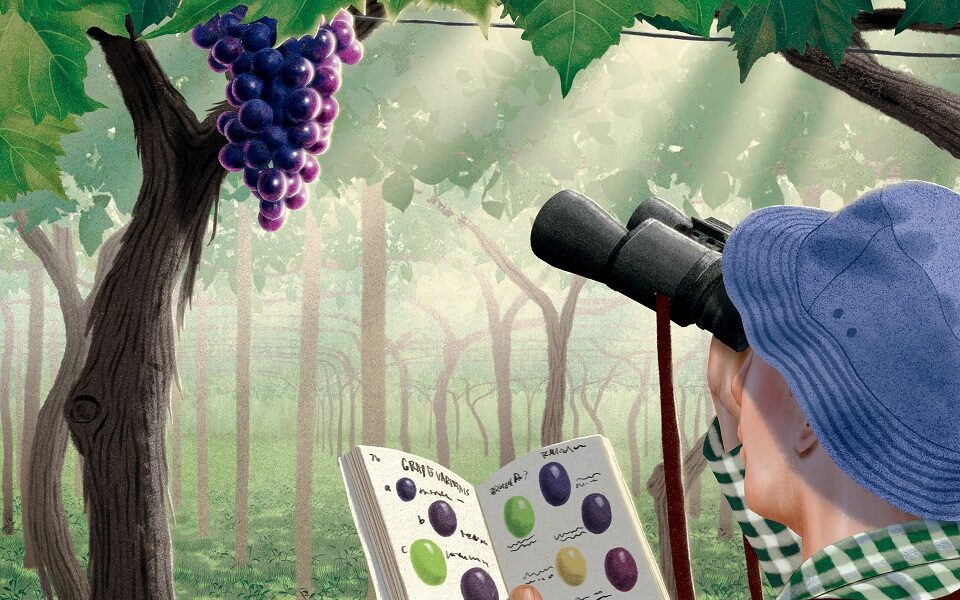10 grapes worth knowing better

A few weeks ago I opened a bottle that caught my attention. It was a soulful, graceful, strikingly pure red from the Aveyron region of southwestern France made by Nicolas Carmarans, a vigneron who makes natural wines from grapes that have long grown in the area.
This particular grape was fer servadou, a variety that to my knowledge I had never tried.
As delightful as I found the wine, my encounter with an intriguing new grape was even more joyful. It was a reminder that no matter how well versed one might be in the intricacies of producers, regions and issues, wine always has more to reveal.
In that spirit, I’d like to suggest 10 grapes that are little-known in the United States but are worth getting to know better. You might not find all of these immediately, but keep your eyes open and try a few. You may be pleasantly surprised.
Grapes and their relative merits are one of the hoarier topics in wine. Some people believe that the hierarchy of grapes has long been set. To stray outside the anointed realm is, supposedly, a waste of time. Retired critic Robert M. Parker Jr. was one of these people, castigating those who would promote what he called “godforsaken grapes.”
I revisit this subject periodically because I believe that we still don’t understand the potential pleasures of hundreds of grapes around the world. So many have been wrongly dismissed because of their place of origin, or because the wines historically made with them were not to modern tastes.
Some of these assessments may have been correct. But not all. Often, it’s a matter of giving lesser-known grapes the same respect and tender care reserved for more esteemed varieties rather than consigning them to the worst vineyard sites and assuming, by way of conventional wisdom, that their potential is meager.
Wine, like food, is a hearty invitation to explore. It could simply be a new producer or an unknown region. Or it might be a completely unfamiliar grape, so all of these elements will be new. You could fall in love.
Sometimes, what seems little-known or obscure becomes well loved. In 2010, I named a dozen grapes that I thought were worth seeking out.
Some of those varieties, like assyrtiko, frappato, mencía and trousseau, have been embraced, though not exactly at a chardonnay level.
It’s important to note that while I have used terms like “obscure” and “little known,” I really mean in American and English-speaking wine cultures. All of these grapes are known and loved by those who farm the vines and make the wine. The rest of us are just catching up.
Here are the 10 grapes, in alphabetical order. Some may be completely unknown to you, others you may have been fortunate enough to have encountered.
Altesse
The Savoie region of France and its neighbors have quite a few little-known grapes that make beautiful wines. Mondeuse, persan and gringet are three. But in my exploration of Savoie whites last year, I fell in love with wines made with altesse. They are fragrant and floral, and rich yet refreshing because of the variety’s bracing acidity. Wines labeled Roussette de Savoie will be 100% altesse. Those from other Savoie appellations like Apremont will be mostly jacquère with altesse sometimes blended in, a combination that can also be lovely.
Areni
Armenia and Georgia sit next to each other on a wide isthmus between the Caspian and Black seas. This area is the Caucasus, thought by many to be one of the points where wine originated. The two countries have dozens of grapes worth getting to know better, but I want to highlight areni from Armenia, a red grape that I have had only a few times, but each time it was startlingly good — lightly tannic yet fresh with stony flavors of red fruits and great finesse. I don’t have a ready source for Armenian wines, I seem to find them by chance. But I’m looking forward to the next encounter.
Baga
This is the leading red grape of the Bairrada region of Portugal. It long had a reputation for making tough, tannic wines, and you can still find examples. These bottles may need years of aging for the tannins to relax. But many growers have recently found that by macerating the juice and the skins of the grapes for shorter periods, they can make fresher, more elegant wines that are vibrant and lively. Filipa Pato & William Wouters make excellent baga wines, as do Sidónio de Sousa, Casa de Saima and Dirk Niepoort.
Bobal
Here is a perfect example of a grape not getting a chance to show its stuff. For centuries it’s been one of the leading grapes of southeastern Spain, though it went ordinarily into nondescript bulk wines. But recently, producers have worked to demonstrate the potential of bobal when farmed conscientiously in the right soils. I’ve found two in particular, Ponce and Mustiguillo, who have shown that bobal can be complex, nuanced, transparent and energetic in the right hands. I have also had an excellent natural bobal from Partida Creus in Catalonia.
Brachetto
I confess that I have not often been moved by brachetto, so I cannot speak unabashedly of its promise. Most brachettos are sparkling and sweet, and I haven’t found them particularly interesting, though they are popular in the Piedmont region of Italy. But I did recently drink a still, dry brachetto from Matteo Correggia that was fragrant and easygoing. I would not argue that it was profound or complex, but it was so delightfully delicious that I wanted to find more.
Fer Servadou
As with brachetto, I cannot claim deep experience with fer servadou, which is often called fer. In fact, the Nicolas Carmarans wine, Maximus, from a biodynamic vineyard on granite soils, is the only one I’ve had, and few other producers who make fer wines are available in the United States. (It is apparently also known as braucol in Gaillac, a region not far from Aveyon.) Regardless, I’m going to try to find more. Meanwhile, fer can take its place next to mauzac, négrette and prunelard, other indigenous grapes of southwestern France intriguing enough to research further.
Frontenac
Hybrid grapes rarely get any respect. Yet here’s a grape that’s a blend of Vitis vinifera, the species that accounts for almost all the best-loved European wine grapes, Vitis labrusca, a species that is native to America, and at least six additional species. Nobody has done more persuasive work on hybrids than Deirdre Heekin and Caleb Barber of La Garagista in Vermont, whose wines are luminous examples of their potential. One of my favorite Garagista wines, Loups-Garoux, is made entirely of Frontenac. I recently opened a 2017 that was fresh and alive, with wild, exotic fruit flavors and stony undertones. I wonder how it will be in another five years. Luckily, I have a few more bottles.
Mandilaria
Greece offers many red grapes that are little known outside their growing regions. One exception is xinomavro, which is the Greek red most likely to make long-lived, complex wines. But others are well worth further attention, like limniona, mavrotragano and mavrodaphne. But I want to mention mandilaria here, which has often been dismissed, even in Greece, as all dark color and tannins with little character. But what if it were made differently? Last years I drank Great Mother red from Stilianou on Crete, which, like the Bairrada producers and baga, treats mandilaria with the lightest of hands. The result was a fascinating pale red, or dark rosé, that was earthy and lightly fruity.
Pecorino
This is one of Italy’s great success stories. According to Ian D’Agata’s excellent “Native Wine Grapes of Italy,” this white grape, which had largely disappeared in the mid-20th century, was resurrected by a couple of producers who were looking for better alternatives among indigenous grapes to the more popular but mediocre varieties that had been planted for their productivity. Now grown primarily in the Marche and Abruzzo, pecorino is sharp, energetic and herbal, beautiful with dishes like linguine in clam sauce. Better producers include Antica Tenuta Pietramore, Tiberio and Cataldi Madonna from Abruzzo.
Trebbiano d’Abruzzese
If trebbiano d’Abruzzese sounds familiar, it’s because “trebbiano” is a name applied to several different Italian white grapes. Most are common but mundane, but not trebbiano d’Abruzzese, a grape that is lively, richly textured, floral and saline. Producers in Abruzzo will tell you that trebbiano d’Abruzzese is in fact rare. Particularly confusing is that the wine, Trebbiano d’Abruzzo, can be made either with trebbiano Toscano, a lesser grape, or the genuine article, trebbiano d’Abruzzese. The key is to seek out reliable producers like Tiberio, Francesco Cirelli, Amorotti and, if you can afford them, Valentini and Emidio Pepe.
This article originally appeared in The New York Times.






